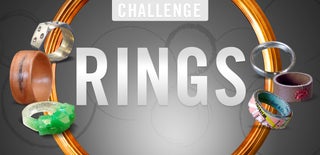Introduction: How to Clean Silver Jewelries and Cutlery
Last week we performed an experiment in chemistry class engaging Redox reactions (for those who are not familiar with the term i will explain shortly but there is also an explanation in Wikipedia).
Redox reactions are reduction and oxidation, the basic is that materials changing electrons between them and by doing so new materials are created.
Anyway the subject of the experiment was cleaning silver and I thought it would be useful and also interesting.
Step 1: Materials
For this project we will need:
- A kettle.
- A bowl.
- Aluminium foil.
- Baking soda.
- Silver cutlery and jewelries.
Step 2: The Cleaning Proccess
The cleaning is done by the next steps:
Put water to boil.
Wrap the inside of the bowl with foil.
Insert everything made of silver you want to clean.
Pour enough hot water to cover everything.
Pour about two teaspoons of baking soda.
During the process you might notice bubbles and a scent similar to eggs or sulfur and that's the sign it works.
Step 3: Conclusion
As you can see in the first photo above the process partly worked and our silver stuff is only a bit cleaner.
There are two possible explanations:
-The metal you tried to clean was not silver or was partly silver.
-The process is needed to be repeated.
And as you can see in the second and third photos the cups are much cleaner now and that is because I have repeated the process once again. The advantage of this method is that it restores the "dirty" silver and does not remove it.
Step 4: Chemical Equitation and Explanation
Well.. in this project we see another use of Red-Ox reactions but lighting fire.
The blackened Silver phenomenon is caused by a pollutant in the air called Hydrogen sulfide (H2S) and that leads us to our first equitation:4 Ag(s) + 2 H2S(g) + O2(g) → 2 Ag2S(s) + 2 H2O(l)
This is a Red-Ox reaction between the silver to H2S, the silver turns into Ag2S and that is the "dirt" we see on the silver.
Now, in order to clean the silver we need to turn the Ag2S into Ag back again, In order to do this we will use a better reducer metal (Reducer is the substance in the reaction that gives electrons) than silver, like Aluminium, that will be oxidized, just as the silver was. The equitation here is:
2 Al(s) + 3 Ag2S(s) + 6 H2O(l) → 6 Ag(s) + 2 Al(OH)3 (s) + 3 H2S (g)
As we can see the Al starts as a solid and turns into Al(OH)3 and the silver, which started as Ag2S turns into Ag.
The scent of sulfur that is noticed during the process is the H2S's smell.
Now a question rises: why did we use Baking soda???
So Baking soda has two roles here:
Firstly, it is a cleaning substance for silver.
Secondly, the soda is a base unlike Hydrogen sulfide which is acid. The Baking soda neutralizes the acid and prevents it from hurting the silver. This happens in the reaction:
H2S (aq) + NaHCO3 (aq) -> NaHS (aq) + CO2 (g) + H2O (l)
After this reaction we're left with water, Carbon dioxide and Sodium hydrosulfide that won't harm silver.
Step 5: All for Now

Participated in the
Rings Challenge

Participated in the
Explore Science Contest

Participated in the
On a Budget Contest













